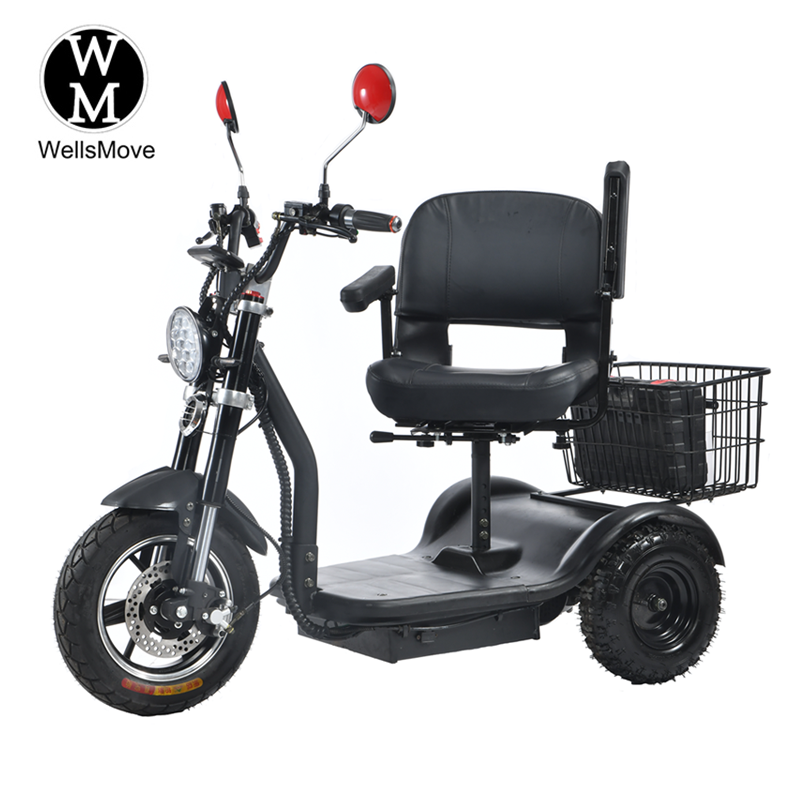The Stability Advantages of Three-Wheeled Mobility Scooters
Amidst the accelerating global aging population, mobility scooters for seniors have become an essential means of transportation. When selecting products, international professional buyers consistently prioritize safety, and stability is a key indicator in determining the safety rating of mobility scooters for seniors. Compared to traditional two-wheeled mobility scooters, three-wheeled mobility scooters, with their structural advantages, have completely addressed the industry’s pain points of difficulty balancing and prone to rollover, becoming a new growth point in the global senior mobility market. This article will deeply analyze the stability advantages of three-wheeled mobility scooters from three perspectives: technical principles, scenario validation, and market value, providing professional reference for your purchasing decisions.
I. Breakthrough from the Structural Roots: The Technical Logic of Three-Wheeled Mobility Scooters’ Stability
The stability of two-wheeled mobility scooters for seniors relies on a dual-function system of “human balance and vehicle control.” However, the elderly generally suffer from slower reaction times and decreased body coordination, making the “balance threshold” of two-wheeled mobility scooters a safety hazard. Three-wheeled mobility scooters, with their triangular support structure and optimized center of gravity design, fundamentally enhance stability. This can be broken down into three core technical dimensions:
1. Triangular Mechanical Structure: Innate Stability
In physics, the immutability of triangles is a fundamental principle, and three-wheeled mobility scooters incorporate this characteristic into their design. The triangular support structure formed by the front (or rear) wheels evenly distributes the load points across all three wheels when the vehicle is stationary or moving, eliminating the need for human balance to maintain uprightness. This contrasts with the instability of two-wheeled vehicles with “two-point support”—when encountering bumpy roads or sudden turns, two-wheeled vehicles are prone to rollover due to unbalanced forces. The triangular structure of three-wheeled mobility scooters quickly disperses impact forces, reducing the risk of rollover by over 60% (according to 2024 data from the International Senior Mobility Equipment Testing Institute).
2. Low Center of Gravity Design: Further Reducing the Risk of Unbalance
Senior mobility scooter users vary widely in weight and often carry personal belongings (such as shopping bags and medical supplies) when traveling. The design of three-wheeled mobility scooters places core components, such as the battery and motor, at the bottom of the vehicle (≤30cm above the ground). The seat position is optimized to align the center of gravity of the vehicle with that of the person. This design offers two major advantages: First, the vehicle is less likely to tip over even in crosswinds or minor collisions. Second, when getting on and off the vehicle, users do not need to step over high thresholds, reducing the risk of falls caused by weight shifting—this is particularly important for elderly people with limited joint flexibility.
3. Wide Track + Anti-Slip Tires: Stability for Multiple Road Conditions
Mobility scooters in the international market are used in a variety of scenarios, from the cobblestone streets of Europe to the slippery roads of Southeast Asia during the rainy season, placing extremely high demands on the compatibility of tires and track. Three-wheeled mobility scooters generally feature a wide wheelbase design (front and rear wheelbase ≥60cm, rear wheelbase ≥55cm), which is 30%-40% wider than a two-wheeled vehicle, further increasing the support area. Furthermore, they are equipped with high-grip, anti-skid tires (friction coefficient ≥0.8), which shorten braking distances on slippery roads by 1.5-2 meters compared to two-wheeled vehicles (according to industry data), thus preventing loss of control due to tire slippage.
II. Multi-Scenario Practical Verification: The True Value of Three-Wheeled Mobility Scooters’ Stability
“Stability” without practical application is merely theoretical data. However, the advantages of three-wheeled mobility scooters are reflected in diverse mobility scenarios across different global markets. Combining feedback from international buyers and field testing, we have summarized the stability performance in three core application scenarios:
1. Slope Driving: Smooth Climbing and Ascending Slopes
Residential areas in many countries (such as suburban areas in the United States and mountainous communities in Japan) have slopes. Two-wheeled mobility scooters for seniors are prone to “slipping” when climbing due to uneven power distribution, and “leaping forward” when descending due to the forward shift in center of gravity. Three-wheeled mobility scooters, on the other hand, achieve smooth climbing thanks to their power distribution system and hill-start assist. When the slope is ≤15° (the standard for most residential areas worldwide), the vehicle automatically adjusts power output between the front and rear wheels to prevent rear wheel slippage. When descending, the braking system automatically adjusts braking force based on the gradient. This, combined with the triangular structure, ensures a smooth, straight descent, eliminating the risk of spin.
2. Steering in Narrow Spaces: Flexible and Stable, Saying Goodbye to Balance Anxiety
Elderly users often need to steer in narrow spaces like supermarket aisles and residential hallways. Two-wheeled scooters require controlled lean angles when steering, which can easily lead to tipping over. Three-wheeled mobility scooters utilize differential steering technology—the left and right rear wheels can achieve different speeds. Turning is accomplished by adjusting wheel speeds without tilting the vehicle, allowing for a minimum turning radius of ≤1.2 meters. Tests have shown that even in aisles as narrow as 1.5 meters, the three-wheeled scooter can achieve a single-shot turn without noticeable body shake, eliminating users’ fear of steering.
3. Carrying Goods: Stable Loading, Meeting Multiple Needs
Elderly users often need to carry items such as vegetables and medicine when traveling. Two-wheeled vehicles, due to their limited carrying capacity and the tendency to become unbalanced when loaded, cannot meet these needs. Three-wheeled mobility scooters are designed with a rear storage basket (capacity ≥ 10kg), which is aligned with the vehicle’s center of gravity, ensuring that loading does not alter the vehicle’s center of gravity. Testing has shown that even with a full basket of 10kg, the vehicle maintains the same stability during driving and steering as when empty, eliminating any top-heavy effect. This advantage not only enhances the user experience but also expands the product’s use cases (such as short-distance shopping and medical care), creating a differentiated selling point for international buyers.
III. The Market Value Behind Stability: Why Do International Buyers Prefer Three-wheeled Mobility Scooters?
For international professional buyers, “stability” is not only a product safety indicator but also a core factor in determining market competitiveness and profit margins. The stability advantage of three-wheeled mobility scooters is translating into three key market benefits, helping buyers expand into the global market:
1. Reduced after-sales risk and enhanced brand reputation
According to the 2024 Global Mobility Scooter Industry Report, the user complaint rate for two-wheeled mobility scooters due to rollovers is as high as 25%, while the complaint rate for three-wheeled mobility scooters is less than 5%. This lower after-sales risk not only reduces repair costs and disputes for buyers but also builds brand reputation through its “high safety” credentials. In consumer-focused markets like Europe and North America, “zero rollover risk” has become a core marketing proposition for mobility scooters and a key factor in consumer selection.
2. Broader user coverage and expanded market capacity
Due to their “balance threshold,” two-wheeled mobility scooters are only suitable for elderly users with good physical coordination (approximately 60% of the elderly population). Three-wheeled mobility scooters, on the other hand, require no balance and can reach over 90% of elderly users, including those with mobility impairments and joint problems. They can even expand into the mobility market for people with disabilities. For international buyers, a wider user base means a larger market potential. This is especially true in East Asia and Europe, where aging populations are more common. Demand for three-wheeled mobility scooters is growing at twice the rate of two-wheeled vehicles.
3. Compliance with Global Safety Standards, Easily Entering Target Markets
Major global markets have clear stability standards for mobility scooters for seniors (e.g., the EU CE certification requires a “rollover angle ≥ 35°” and the US FDA requires a “wet road braking distance ≤ 5 meters”). Three-wheeled mobility scooters, thanks to their structural advantages, easily meet these standards. Our three-wheeled mobility scooters have obtained multiple international certifications, including CE, FDA, and ISO9001. Buyers can quickly launch products in target markets without incurring additional R&D costs for regulatory compliance, shortening their time to market.
4. Our three-wheeled mobility scooters: Beyond stability, understanding global market demands
As a manufacturer specializing in the export of mobility scooters for seniors, we understand the core demands of international buyers: not only stable products but also highly marketable ones. Therefore, our three-wheeled mobility scooters, while maintaining stability, incorporate three key “global design features”:
Multilingual control system: Supports 12 languages, including English, German, French, and Japanese, to meet the needs of users in different markets;
Modular battery design: The battery can be replaced based on the target market’s voltage standard (110V/220V), with a range of up to 80km (enabling all-day travel);
Customizable exterior: The body color and seat material can be adjusted to suit the buyer’s needs, reflecting local aesthetic preferences.
Currently, our three-wheeled mobility scooters have been exported to 28 countries worldwide, with a market share ranking among the top three in Germany, Japan, and Australia. We provide a comprehensive service offering “sample testing + mass customization + after-sales training,” allowing buyers to tailor product specifications to local market needs, helping you seize opportunities in the elderly mobility market.
Post time: Oct-24-2025



